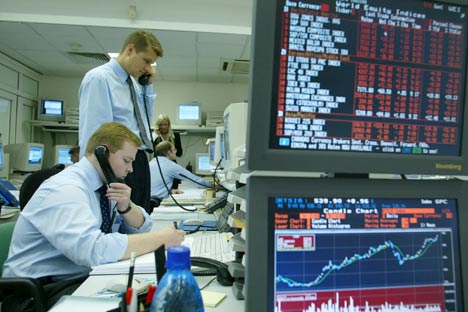Wave of pessimism bypasses Russian investment market

Uralsib Capital: “Russia still looks fairly attractive, which confirms our assumption concerning deferred response from Russia-focused investment funds.” Source: ITAR-TASS.
According to Emerging Portfolio Fund Research (EPFR), funds concentrated in Russian stocks received a net cash inflow of $104 million during Sept. 19-26. According to Uralsib Capital analysts, the week’s investment inflow topped the previous week’s figure of $92 million, almost hitting a new high since mid-April. Even the negative trend on the RTS stock exchange index did not hinder investors.
Of the emerging markets, only China managed to outstrip Russia in terms of investment, with $247 million raised during the week; India and Brazil fell behind with $54 million and $74 million, respectively.
Related:
Foreign banks may contribute to Russia's economy
“This is the biggest investment inflow into mutual funds focused on Russia over the past eight weeks. Market signals are inspiring hope,” said the chief analyst at Alfa-Bank, Angelika Henkel.
On Sept. 13, the U.S. Federal Reserve announced a new round of so-called quantitative easing, promising to buy $40 billion in mortgage bonds on the market each month. While the move discouraged investors, this wave of pessimism has not yet reached developing markets.
“Russia still looks fairly attractive, which confirms our assumption concerning deferred response from Russia-focused investment funds,” sources at Uralsib Capital said.
Meanwhile, experts have been pointing to a number of disturbing factors for the Russian market. Despite the positive flow of cash into Russian stocks, some equity funds are curbing their presence in Russia. One of the world’s biggest investment management firms, Blackrock, has cut Russia's weight in its 2012 portfolio from 0.7 percent at the end of the first quarter to 0.3 percent in the third quarter – both indicators are down from 0.9 percent in January. In selling out Russian assets, the fund followed the lead of Sweden’s Vostok Nafta Investment and America’s Third Millennium Russia fund.
“Funds are pulling out of Russian assets: they are wary of investing in Russia,” a portfolio manager at a big investment company said.
As Third Millennium Russia was closing in August, the fund’s portfolio manager and founder John Connor said that American investors no longer had confidence in developing markets. “At its peak, the fund had $190 million of assets under management; but the assets shrank sharply this year, following a 20 percent rise in January and February,” Bloomberg quoted John Connor as saying. “Funds focused on the developing markets lost investor confidence after the crisis of 2008.”
Net investment inflow — September 19-26, 2012
| China | $247 million |
| Russia | $104 million |
| Brazil | $74 million |
| India | $54 million |
First published in Russian in Gazeta.ru.
Comments from experts
Vladimir Pantyushin, the chief economist for Russia and the CIS at Barclays Capital in Moscow:
"I expect the ruble to grow in the coming autumn months. Our national currency traditionally moves against a very special background and is fairly dependent on the dollar and the euro. The main factor keeping the ruble in check is capital outflow. If it were just for the general economic situation, the ruble would already be going up. We have seen a fairly big currency influx on our current account; oil prices are high; exports have outpaced imports; our current account, as well as our trading account in general, is still fairly high. But there’s also a very important constraining factor at work: capital outflow. That is, export proceeds may never even reach Russia, so the ruble cannot actually strengthen. I believe that the outflow will subside in the next few months – certainly not down to zero but still enough to back the ruble’s rise."
All rights reserved by Rossiyskaya Gazeta.
Subscribe
to our newsletter!
Get the week's best stories straight to your inbox